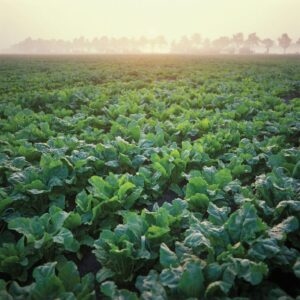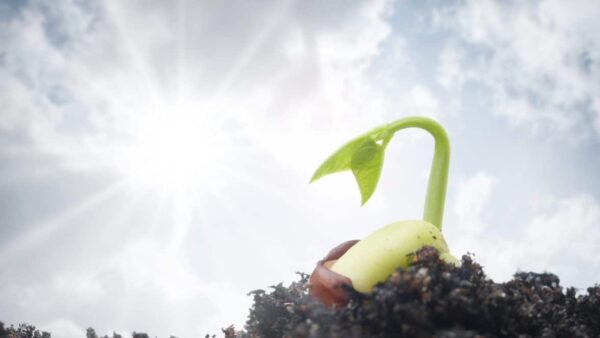With the bases loaded, the vegetable industry steps up to the plate to improve access to plant breeding traits.
Those who have followed the debates on intellectual property in the seed industry may have noticed the increasing number of discussions about patents on plant breeding traits over the past years – especially in Europe.
The industry has been divided into two rival teams — those in favour of such patents and those who are not. The proponents state that these patents will foster innovation, knowledge-sharing and continued investments in research and development. Those who are against such patents argue that they are unnecessary because of the intellectual property protection offered by plant breeders’ rights. They also claim that patents impede the work of breeders — that they can no longer gain access to biological materials, or can do so only after a delay or at a high cost.

director.
Many companies rely on access to germplasm, and this makes the debate highly relevant for breeding companies that develop new plant varieties. While the debates continue, the International Licensing Platform (ILP) Vegetable was launched in November 2014 to showcase a proactive and progressive path forward. This new platform is comprised of members from the vegetable breeding industry. Eleven companies, which represent both publicly-traded companies and family businesses from Switzerland, Germany, Japan, France and the Netherlands (and collectively more than 50 per cent of the global vegetable seed market), have worked together to establish the ILP. The member companies include:
- Agrisemen
- Bayer CropScience (Nunhems)
- Bejo Zaden
- Enza Zaden
- Holland-Select
- Limagrain Vegetable Seeds
- Limgroup
- Pop Vriend
- Rijk Zwaan
- Syngenta
- Takii
Membership is open to all interested parties, regardless of whether they own patents or not.
“For several years there were discussions in society and politics about the desirability of patenting biological material in relation to access to such material for breeding. Also in the plant breeding industry this discussion took place, leading to statements and position papers of the organisations active in the breeding sector like ISF, ESA and Plantum,” ILP managing director Chris van Winden says.
“Eleven vegetable breeding companies took the initiative, stimulated by the Dutch Parliament, to investigate a system that would help to safeguard worldwide access to biological material that is covered by patents of their competitors. During a period of around four years, discussions and negotiations took place in a steering committee that consisted of the 11 vegetable breeding companies. The successful result was the formation of the ILP.”
Practical Solutions
Member companies concur.
“Syngenta is proud to be a founding member of the International Licensing Platform, and we fully support this new business association to improve access to and use of plant breeding traits for vegetables,” Syngenta licensing head Leo Melchers says. “The ILP provides a straightforward, easy way for vegetable breeders to license the innovative traits they need at a fair and reasonable cost.
“Like Syngenta’s e-licensing platform, www.traitability.com, the ILP shows that practical solutions can be found by industry players, which balance the need for the innovation incentives of patents with the need to ensure access to crucial biological material for the plant breeding community. The ILP will help plant breeders bring new products to the market that meet demands from growers and consumers, and that helps the world address food security.”
The aim of the ILP is to provide an easy way for vegetable breeders around the world to license the traits they need in their breeding activities at fair and reasonable cost so that they can bring new products to the market that meet the demands from growers and consumers.
“We are a vegetable breeding company, aiming to develop the best vegetable varieties. In order to be able to provide the market with good new varieties, we need access to biological material, available in the market and other genetic resources like gene banks,” Ben Tax, managing director of Rijk Zwaan in the Netherlands, says.
If this access is blocked because it’s covered by a patent claim, developers are hindered in developing new varieties, Tax notes. “In general, innovation will be slowed down, which is bad for the entire sector and for the total world’s food supply. The members of the ILP guarantee the other members access to biological material covered by their patents, at reasonable prices. And these reasonable prices will be determined by independent experts.”
The members of the ILP are required to make all their patents related to vegetable breeding traits, including published applications, accessible to their fellow members under the conditions of the ILP.
According to Michael Kock, head of intellectual property for Syngenta, the ILP is important for many different reasons.
“First, and maybe most important, it demonstrates that patents as incentive for technical innovations in plant science and free access to breeding material are not an unresolvable contradiction,” he says.
“The ILP is based on the principle ‘free access but not for free’, which provides open access for a fair benefit sharing with the innovator. We hope that the ILP, as a constructive solution, could be a role model [for] how to re-align the seed industry to reduce internal debates and [free up energy] for the big challenges that lay ahead of us — for example, developing new varieties that meet consumer demands, deliver higher yields and help farmers deal with climate change. Second, it provides a platform [for] how we can offer and access plant-related inventions in a very pragmatic way with low transactional costs and under fair, reasonable, and transparent conditions.”
According to Melchers, the license fees are only paid once a new variety deriving from the patent is being brought to market. “The ILP is set up to become the main trading platform for vegetable-related patent inventions and a role model [for establishing] an ‘open IP’ regime in the seed industry.”

Simple and Transparent
The ILP’s licensing system is simple, transparent and operates at low transaction costs (i.e. using standard contracts). If a member wants to take a license to use a fellow member’s patented invention, the two parties begin bilateral negotiations. If no agreement is reached within three months, the case is submitted to independent experts. The innovative aspect of the system is the method of decision-making by the independent experts. It uses a baseball arbitration model, whereby both parties submit their license fee proposal to the independent experts, who then choose only the most reasonable proposal among the two, but cannot mediate a compromise.
This forces both parties to adopt reasonable positions from the outset, because an unreasonable position will be rejected in favour of a more reasonable competing proposal and the “losing” party will need to pay the costs of the arbitration process. Once the experts set a license fee, this fee is communicated to all other parties to increase transparency.
“All members have filled out a patent registration form and all members of the ILP have received information about the list of registered patents,” Winden says. “At this moment around 120 patents are in the system.”
In the first general meeting of the ILP it was decided that the information about the patents would be publicly available and soon it will be clear how many and which patents are included. However, this is not all. In addition to patents pertaining to traits, also patents granted on plant varieties as such are covered by the ILP.
In practice this only applies to U.S. patents, as in Europe plant varieties as such are excluded from patentability. However, instead of the baseball procedure, a so-called non-assert provision applies for the use of patented material for breeding purposes. This creates a kind of breeder’s exemption under the U.S. patents provided that the resulting new varieties that are bred by using the protected variety are sufficiently different from that protected variety. These patents will not be included in the register as it is not that difficult to look these patents up in public patent databases. In any case, the number of these patents will exceed the number of patents pertaining to traits. This non-assert is mutual but free of charge and requires a simple notification to the patentee.
What does Tax and his company hope to gain from the process? “For ourselves, broader access to biological material, which we need to continue to develop top vegetable varieties,” he says, “and for the entire sector to avoid serious limitations of open innovation, which always has been a success factor and could be realized by applying the breeders’ exemption as incorporated in the Plant Breeders’ Rights system.”
Michael Kock says Syngenta might be one of the first users of the ILP.
“The ILP has two pillars,” he says. “Under Pillar 1, companies can obtain licenses to patented vegetable characteristics in an easy way for a reasonable fee. Under Pillar 2, the member companies agree to a mutual non-assert under variety patents — this establishes a breeders’ exemption for patent-protected varieties. This non-assert is free of charge and requires a simple notification to the patentee. Syngenta has already made use of this and sent two notifications. We hope that the ILP becomes ‘the’ trading platform for vegetable related patent inventions and a proven model of how to establish an ‘open IP’ regime in the seed industry.”
Obviously, with any such type of industry cooperation, anti-trust laws need to be taken into account.
“The discussions in the steering committee took place in a very positive atmosphere. An important point during all discussions was that the system and license agreement must be in compliance with competition law. Therefore, a law firm with specialized knowledge on all aspects of competition law guided the whole process,” Van Winden says. “In addition, a representative of the Dutch government was present in the steering committee meetings. At the end of the discussions, law firms in the EU and U.S. assessed the result and concluded that the ILP is in compliance with the competition laws in the EU and U.S.”
Growing the ILP
The 11 member companies represent more than 50 per cent of the global vegetable seed market.
“For companies wishing to get a license for a patent covering biological material of one of the members of the ILP, membership in the ILP means guaranteed access to these patents under fair and reasonable costs. The licensing system is simple, so the costs will be low and the duration of the process is limited. All legal entities can be a member, even if an entity does not own patents,” van Winden adds.
The current members would like the association to grow. “The more companies with relevant patents who join the ILP the better [so] open innovation can be continued, which is in the interest of the entire sector and society,” Tax says.
Syngenta concurs: “We hope that not only companies, but also universities and agricultural research institutes, will join the ILP. For universities, the ILP would be a great opportunity to make their plant-related innovations available at low transaction costs to many players,” Kock adds.
Members of the ILP have to pay an annual contribution fee to the platform that covers all costs of membership. The current annual contribution fee, which may be reduced if more members join, is:
- € 7 500 for small companies(<100 employees)
- € 15 000 for medium companies (100 < 500 employees)
- € 22 500 for large companies (> 500 employees)
“ILP is a unique system and not comparable with any other system or initiative. In this system, the members have the obligation to bring in all their relevant patents. This is different from e-licensing platforms set up by individual companies. Also, the system is simple and transparent and the method of decision-making is very innovative,” van Winden says.
While the aim of the Pinto database established by ESA (pinto.euroseeds.eu) is to provide transparency of information about which varieties are actually covered by a patent, the ILP’s aim is to offer guaranteed access to all patents covering biological material of the ILP members.
For the moment, this kind of licensing platform exists only for vegetable crops — but van Winden says that could change.
“During the launch of the ILP at a symposium last November in Wageningen, there was a lot of interest from breeders outside the vegetable sector, especially the ornamental sector. It is up to other sectors to decide whether the initiative of the vegetable sector will be followed and of course, if so, the ILP is quite willing to share their experiences [with] the process to establish a similar system for their own crops. But as the ILP is specifically designed for vegetable crops, it is not [expected] that other sectors would be a new branch of the ILP.”
The ILP was formed to show that proactive solutions can be found that balance the need for continued innovation with the need to ensure access to beneficial plant breeding innovations, Melchers says.
Joining ILP Vegetable
All interested companies, universities or institutes, regardless of whether they own patents or not, are welcome to become an ILP member. Interested parties should contact Chris van Winden (managing.director@ILP-vegetable.org) for more information on how to join the ILP.













